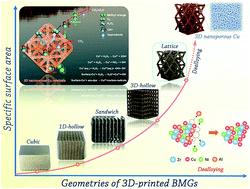Excellent degradation performance of 3D hierarchical nanoporous structures of copper towards organic pollutants †
Abstract
Advanced oxidation processes provide a promising way to the degradation of organic pollutants in wastewater, wherein developing highly efficient catalysts is of paramount importance. Herein, three-dimensional (3D) hierarchical nanoporous structures of Cu catalysts with desirable geometries were synthesized by laser 3D printing combined with chemical dealloying. The resulting 3D nanoporous Cu (3D NP-Cu) exhibited a 660-fold larger specific surface area than conventional 2D ribbons or powder catalysts. The 3D NP-Cu catalysts exhibited high degradation efficiency towards azo dyes with a kinetic reaction constant of 0.147 min−1, which is 14 times higher than that of the commercial catalyst of Cu2+ and 4 times higher than that of Cu0 powder. Impressively, the 3D NP-Cu exhibited fairly good reusability and excellent versatility, as indicated by the fast degradation of the mixture of complex dyes and reduction of the chemical oxygen demand (COD). The extraordinary catalytic activities of the 3D NP-Cu catalysts originated from their unique 3D hierarchical mill/nano-porous structures with large surface areas and numerous active atomic steps on Cu ligaments, which generate abundant active species and accelerate the transport of reactants. In addition, the presence of a small amount of Cu+ active species in the as-prepared 3D NP-Cu catalyst also played a critical role in promoting the degradation process, leading to the decomposition of azo dyes even in the absence of H2O2. Moreover, two possible pathways of degradation towards azo dyes were proposed based on liquid chromatograph-mass spectrometry analysis, i.e. reduction of azo bonds and demethylation of MO. The current work may inspire the development of new types of 3D nanostructured metal catalysts for remediation of wastewater.



 Please wait while we load your content...
Please wait while we load your content...